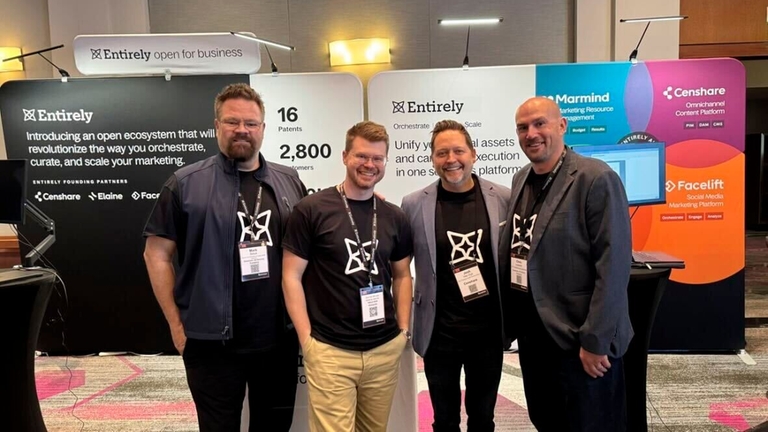Marketers are reacting to shifts in AI-related consumer behavior with dramatic statements like "SEO is dead."
But rather than relying on LinkedIn for what's shifting, consider three expert perspectives captured in this blog. Read on for strategic market observations from Dr. Sören Lüders (Slalom Germany); current US market intelligence from Nick Miller (Slalom U.S.); and enterprise technical realities from Raymond Groos (Censhare).
What’s happening: AI is changing Search, Shop, and Discovery
1) Feedback loops are being rewritten.
Traditional feedback loops—i.e., the cyclical systems where customer actions generate data, which informs marketing decisions, which then influence customer behavior, creating a continuous loop—these have traditionally been about the interactions between brand and customer.
"But what we see is this change towards brand and AI interaction. So the customer doesn't really have a direct interaction with the brand anymore–or at least that's where we are headed. The field is changing dramatically."
Dr. Sören Lüders, Director of Marketing Solutions
Slalom Germany
Old model: Brand ↔ Customer (Direct)
Emerging model: Brand ↔ AI ↔ Customer (Mediated)
In Search, Shopping, and Discovery, companies will increasingly need to compete for the bot's trust, attention, and recommendation, rather than the customer's.
Moreover, bots may increasingly make purchases for the customer. "Predictions show that around 30% of revenue will come from shop bots, rather than customers," says Lüders. In early October 2025, Google launched their AI mode in the DACH regions, but most companies haven't yet realized that change, says Lüders, and even fewer have optimized for it.
2) AI is creating demand, not just capturing it.
Fresh from an AI measurement event in New York, Slalom’s Nick Miller shared days-old intelligence that reinforces Lüders' observations about behavioral shifts:
~41% of ChatGPT searches that do not prompt a product response end up guiding the user through a purchase behavior.
"Someone writes, 'my back hurts while I'm working at home.' They're not asking for a product, yet the AI recommends an expensive ergonomic chair. They end up purchasing it, even though they weren't initially looking for a product."
Nick Miller, Senior Director of Marketing
Slalom U.S.
~60% of people using AI as a research assistant trust the AI platform's recommendations more than they trust the recommendations of their own friends, said Miller.
With these rapid shifts in consumer behavior, Miller says marketers are starting to shift from reactive marketing to predictive marketing, which means utilizing sophisticated data models to know which past behaviors will influence future needs, rather than waiting on the customer to tell brands what they're looking for.
3) Your AI presence = your brand presence.
This shift in how customers discover and evaluate brands has profound implications for brand identity itself.
"Your AI presence is essentially becoming your brand's presence... You're ultimately interacting with an algorithm that has formed an opinion about your brand and that opinion is what is being shared."
Nick Miller
Case in point: AI as primary brand interface
Norwegian Cruise Lines approached Slalom with a critical conversion problem: visitors were abandoning their website before entering the booking engine, resulting in declining reservations. Slalom developed Nora, an AI booking assistant built on OpenAI and AWS, designed to guide customers through the notoriously complex cruise booking process—helping them select cabins, pre-book excursions, and answer questions in real time. The result was dramatic: a 58% increase in visitors progressing into the booking experience. What makes this case study particularly relevant is how it demonstrates the shift from AI as a novelty feature to AI as the primary brand interface. More than simply assisting with bookings, Nora became Norwegian Cruise Lines' brand presence for customers at the critical decision moment, proving that the quality of the AI experience directly impacts whether customers perceive the brand as helpful and trustworthy—or friction-filled and overwhelming.
Opportunities: What AI enables now
1) Deploy Marketing Mix Model, powered by AI.
Understanding these shifts in consumer behavior is critical, but Lüders points out a frustrating paradox: we're all chasing shiny new AI toys while ignoring the "boring" AI tool that could actually save CMOs' jobs right now. He uses Marketing Mix Modeling (MMM) as an example. This used to be hard, but AI made it easy. CMOs are under huge pressure to prove marketing ROI, and MMM does exactly that; yet almost nobody uses it—they're too busy chasing flashy AI projects instead.
Companies should consider the practical AI tool that solves their most urgent problem (proving marketing value) instead of obsessing over experimental AI tools that may or may not pay off.
2) Shift from reactive to predictive analytics.
From a technical and organizational perspective, Raymond Groos sees similar opportunities being underutilized. Companies should employ AI to analyze and connect data points to predict which segments are most likely to convert, rather than asking (reactively) “what did your data and content do?”
Similarly, while personalization at scale is a years-old imperative, AI combines all the different data sources that are available, making it easier to get one-to-one communication and personalization. This derives not from Google searches but from conversations with an AI agent or an AI assistant.
3) Prepare your content for personalization (now more possible than before).
AI now makes true one-to-one personalization achievable by connecting multiple data sources—not through search behavior, but through conversational interactions with AI agents and assistants. To deliver personalized experiences, companies must have a large volume of content “ready out of the box.” That means not just using AI to generate content, but designing the right messages, metadata, and formats so AI systems can understand and serve them accurately. The content itself becomes the foundation of personalization, so it must be structured, tagged, and contextually rich for machine interpretation.
4) Prepare campaigns for two audiences: Human customers + AI systems.
Campaigns are no longer just conversion engines—they train AI systems that influence future recommendations. Traditional multichannel campaigns (social, email, paid, PR) remain essential, but marketers must now treat AI platforms as a new distribution channel, optimizing content for how AI agents read, learn, and respond. When launching products, push marketing still creates awareness, yet those same assets—press releases, product pages, blog posts—also become AI training data.
AI can dynamically manage campaign performance, reallocating budgets across underperforming channels in real time, but humans must still oversee the creative and strategic mix. The goal is a hybrid model: traditional channels for awareness and engagement, AI-optimized channels for intelligent amplification.
5) Bolster your content infrastructure and governance.
Because AI continuously reuses the content it ingests, accuracy and structure have never mattered more. In the past, one bad ad could be paused; now, an error in a single asset can misinform AI at scale—locking in false brand “understandings” that persist across thousands of recommendations. Enterprises are producing massive content volumes for both human and machine audiences—across segments, regions, and use cases—yet without rigorous governance, tagging, and version control, they risk feeding AI conflicting or incorrect data.
If inaccurate or poorly structured content is published, this is the fallout:
- AI ingests it → AI misunderstands your product
- Customer asks AI → AI gives wrong recommendation or description
- Customer has bad experience or doesn't buy
- AI learns: "Recommending this product led to poor outcome"
- AI STOPS recommending you → Vicious cycle
At the same time, AI agents dramatically increase system load: thousands of simultaneous queries and millions of API calls per day. To handle this, organizations need:
- Scalable infrastructure to absorb AI traffic,
- Composable systems to swap out rapidly evolving AI tools, and
- Clear, machine-readable APIs to ensure AI interprets data correctly.
Without these, companies face data misinterpretation, infrastructure strain, and long-term brand distortion.
Risks: What not to do
1) Top-down AI mandates lead to brand damage.
One of the worst mistakes organizations make is adopting AI reactively from the top down because leadership feels pressure to "do something with AI." This often happens when executives see competitors experimenting with AI and fear falling behind, so they issue vague mandates for teams to launch "an AI project."
Without clear goals or user research, this typically results in superficial solutions—like poorly designed chatbots that don't solve real customer problems. "This chatbot is now your brand presence, and if it's not a good experience or not fulfilling the needs of customers, that's a problem," says Lüders. Instead of enhancing the brand, these tools damage it by creating frustrating, low-value experiences. "Companies end up in a project with us saying, 'hey, we need to find an AI tool, AI solution—but that's the wrong approach."
Lüders recommends starting from customer needs and business value, not executive anxiety or trend-following.
2) Technology without organizational readiness fails.
Even when companies avoid the top-down mandate trap, they often fall into another: assuming that getting the technology right is enough.
"Data and technology is definitely important... but one of the most important factors is the organization and the people. You can have the best data, the best tech. If the processes are not aligned to use this new technology or AI solution, if the people are not trained on it, they're not going to use it. It's worth nothing."
Dr. Sören Lüders
Lüders specifically mentions:
- Change management is critical
- Training must be embedded in actual workflows (not separate "AI training")
- Any AI solution enablement should include training upfront
- This is why POCs don't scale—lack of organizational adoption
"We see a lot of POCs which fail to scale because they work on a data silo or information silo. There's no interaction between other departments. Or they do have access to the data, but it's a different taxonomy, so they can't use it."
Dr. Sören Lüders
What works: Framework for successful AI adoption
All three experts converged on the same framework for successful AI adoption:
- Start with ONE high-value, measurable use case (not twenty)
- Define the business problem first (not the technology)
- Pilot with clear success metrics
- It's okay to fail fast and learn
- Only scale after proving ROI
“Start with a potentially high value, high impact and measurable use case, but define what the business problem or business opportunity is upfront before selecting the technology."
Nick Miller
Slalom U.S.
AI-ready diagnostic: Where does your organization stand?
Visibility and discoverability:
- Can AI agents accurately find and describe your brand?
- Is your content structured, tagged, and contextually consistent across systems?
Infrastructure and integration:
- Are your APIs and data sources documented for machine interpretation?
- Can your systems handle AI-driven traffic and updates without distortion?
Governance and strategy:
- Do you have guardrails for what AI systems can access or publish?
- Do all AI initiatives map to measurable business KPIs?
The content you create today for your campaign teaches AI systems how to describe your brand for years to come.
These insights come from a panel discussion featuring Dr. Sören Lüders (Director of Marketing Solutions, Slalom Germany), Nick Miller (Senior Director of Marketing, Slalom U.S.), and Raymond Groos (Global Director Solution Consulting, Censhare), moderated by Patrick Moser (Co-CEO, Marmind), October 2025.







